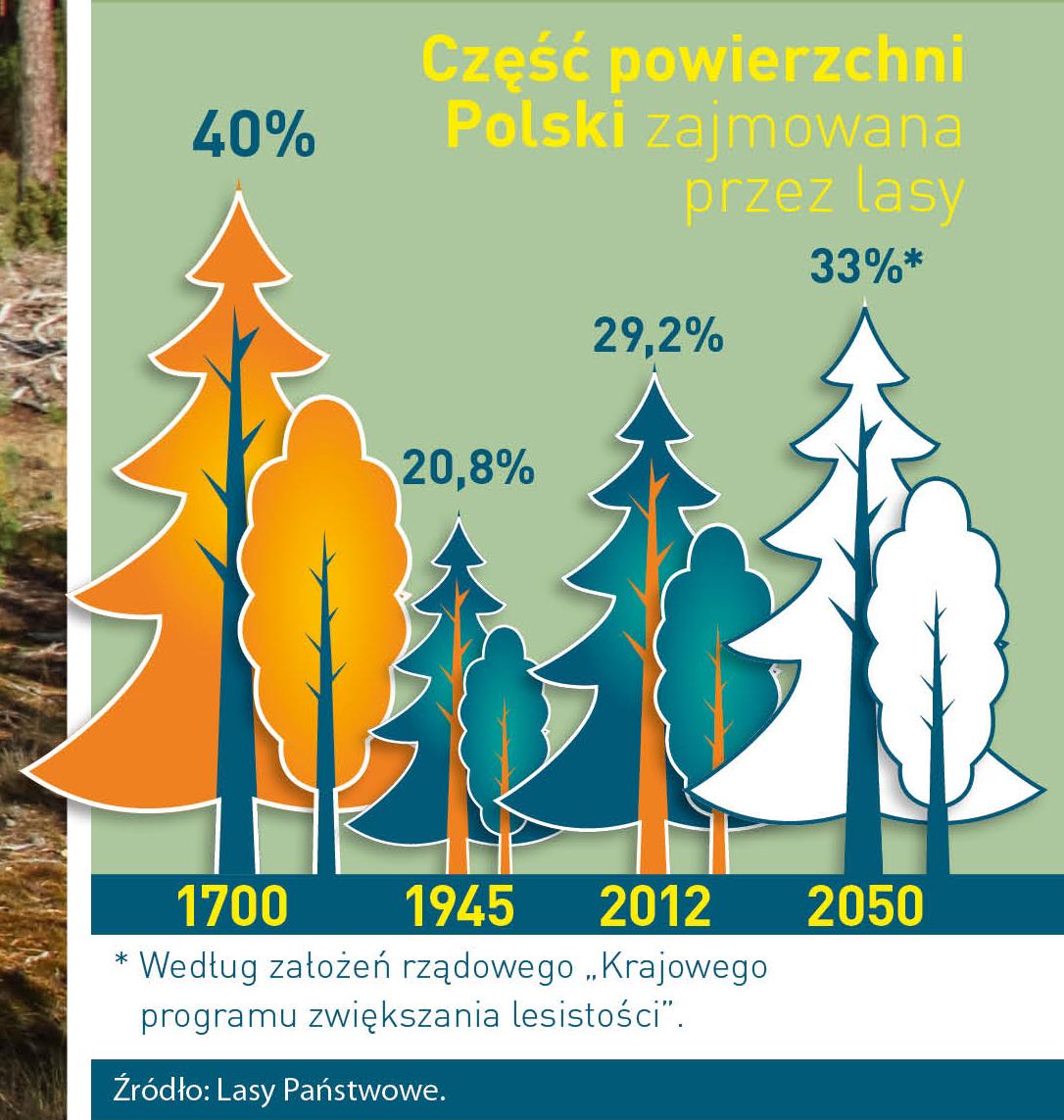 Asset Publisher
Asset Publisher
Polish forests
Poland is in the European lead, while concerning the area of all forests. They cover about 29,2 % of the country territory, and grow within the area of 9,1 million hectares. The overwhelming majority of the forests is state owned, of which almost 7,6 million hectares are managed by the State Forests National Forest Holding..
The number of Polish forest is still growing. The forestation rate of the country has increased from 21 % in 1945 to 29,2 % at the moment. Between 1995 and 2008, the forest area increased by 310 thousand ha. The basis for afforestation works is the "National Programme for Increasing the Forest Cover" (KPZL), assuming an increase of the forestation rate up to 30 % by 2020 and up to 33 % by 2050. Polish forests abound in flora, fauna and fungi. 65 % of the total number of animal species live there.
The forests grow in our country on poor soils, mainly because of the development of the agriculture in previous years. It influences the distribution of the types of the forest sites in Poland. Over 55 % of the forest areas is covered with coniferous forests. In other areas, there are forest sites, mainly the mixed ones. Their small part constitute alder and riparian forests – not more than 3 %.
In the years 1945 – 2011 the area of natural deciduous tree stands within the area of the State Forests National Forest Holding increased from 13 to 28,2 %.
Within the lowlands and uplands the most often occurring tee species is pine. It covers 64,3 % of the forest area of the State Forests National Forest Holding and 57,7 % of private and commune forests. In the mountains the predominant species is European spruce ( in the west) and European spruce with beech (in the east). Domination of pine is the result of carrying on sustainable forest management in the past. Once, the monocultures (crops or cultivations of one species) were the answer to the great demand of industry for wood. Such forests appeared to be quite fragile to climatic factors. They also were often the prey of pests' expansion.
In Polish forests, the share of other tree species, especially deciduous trees have been systematically increasing. The foresters have stepped aside from monocultures – that is why, they try to fit specific species of the forest stand to the natural stand, that would be proper for the given area. Thanks to that, in the years 1945 – 2011, the area of the deciduous tree stands within the lands of the State Forests National Forest Holding increased from 13 to 28,2 %. There occur more and more frequently the following tree species: oaks, ashes, maples, sycamore maples, elms, but also birches, beeches, alders, poplars, hornbeams, aspens, tilias and willows.
Our forests are the most often represented by the forest stands aged 40 to 80 years. The average age of the forest equals 60 years. More and more trees are of big size at the age over 80 years. Since the end of the Second World War, the forests' area has increased up to almost 1,85 million hectares.
Raport o stanie lasów w Polsce 2012
 Asset Publisher
Asset Publisher
 Asset Publisher
Asset Publisher
Warsztaty bartnicze
Warsztaty bartnicze
 foto. Archiwum N-ctwa
foto. Archiwum N-ctwa
 foto. Archiwum N-ctwa
foto. Archiwum N-ctwa
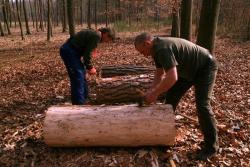 foto. Archiwum N-ctwa
foto. Archiwum N-ctwa
 fofo.Archiwum N-ctwa
fofo.Archiwum N-ctwa
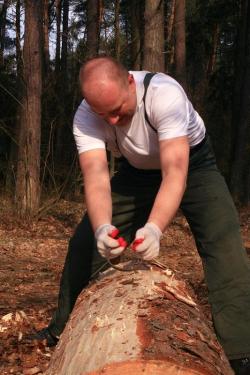 foto. Archiwum N-ctwa
foto. Archiwum N-ctwa
 foto. Archiwum N-ctwa
foto. Archiwum N-ctwa
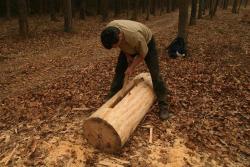 foto. Archiwum N-ctwa
foto. Archiwum N-ctwa
 foto. Archiwum N-ctwa
foto. Archiwum N-ctwa
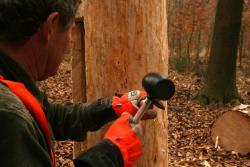 foto. Archiwum N-ctwa
foto. Archiwum N-ctwa
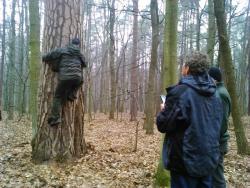 foto. Archiwum N-ctwa
foto. Archiwum N-ctwa
"Bartnictwo jest niezwykle pożądane w lasach – zwiększa liczbę zapylaczy roślin leśnych, przyczynia się do ochrony starych najcenniejszych lasów, może stanowić produkt regionalny dla lokalnej społeczności, a także być atrakcją ściągająca rzesze turystów…"
Tradycje bartne związane z dzikimi pszczołami zaniknęły w Polsce w XVIII wieku i na początku XIX wieku nie tylko z powodu rozwoju rolnictwa, przemysłu ale i nowych jak na tamte czasy metod hodowlanych. Tradycje bartne przetrwały natomiast do dziś na południowym Uralu, w Republice Baszkortostan w Rosji. Miód produkowany przez dzikie pszczoły jest tam towarem bardzo poszukiwanym na całym świecie.
Początek tej historii zaczyna się w roku 2006, kiedy to na zaproszenie Spalskiego Parku Krajobrazowego do Polski przyjechało dwóch bartników z Baszkirii (azjatycka część Rosji), którzy w kilku wiekowych sosnach w lasach spalskich wydrążyli barcie i nauczyli zapomnianego fachu Polaków. Wśród nich był leśniczy Andrzej Pazura.
Obecnie odtworzenie bartnictwa budzi duże zainteresowanie wśród leśników na terenie całego kraju, dlatego też w dniu 27 marca bieżącego roku w Nadleśnictwie Spała zorganizowano pierwsze warsztaty bartnicze. Pod okiem doświadczonego bartnika Pana Andrzeja Pazury – leśniczego leśnictwa Jasień, uczestnicy warsztatów z nadleśnictw: Płytnica i Katowice nabywali wiedzę zarówno teoretyczną, jak i praktyczną z tego zakresu.
Na wyrzynkach, przygotowanych ze starej spalskiej sosny, uczestnicy uczyli się krok po kroku dziania kłody bartnej. Mieli również możliwość wykonania barci w stojącej sośnie przeznaczonej do zasiedlenia przez pszczołę leśną. Pan Andrzej – prawdziwy pasjonat pszczelarstwa uatrakcyjniał zajęcia ciekawostkami na temat technik pozyskiwania miodu i wosku. Po zakończeniu zajęć uczestnicy otrzymali wykonane przez siebie kłody bartne, które będą mogli zaprezentować współpracownikom, przekazując przy tym wiedzę zdobytą podczas zajęć, między innymi to, że barcie wydrążane są w żywym drzewie, zaś kłody bartne, to wieszane na drzewach kawałki drewna, przeważnie o długości 1,5-2 m, przygotowywane specjalnie dla pszczół.
Akcentem kończącym warsztaty było pokazanie uczestnikom najciekawszych miejsc Spały, m.in. Groty Św. Huberta, Kościoła pw. Matki Bożej Królowej Korony Polski, pomnika Żubra, a także zapalenie symbolicznego znicza pod pomnikiem Leśnika przy Domu Pamięci Walki i Męczeństwa Leśników i Drzewiarzy Polskich im. Adama Loreta.


 fot. Paweł Fabijański
fot. Paweł Fabijański
 fot. Paweł Fabijański
fot. Paweł Fabijański
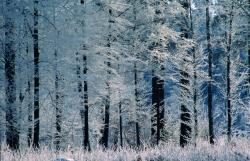 fot. Paweł Fabijański
fot. Paweł Fabijański
